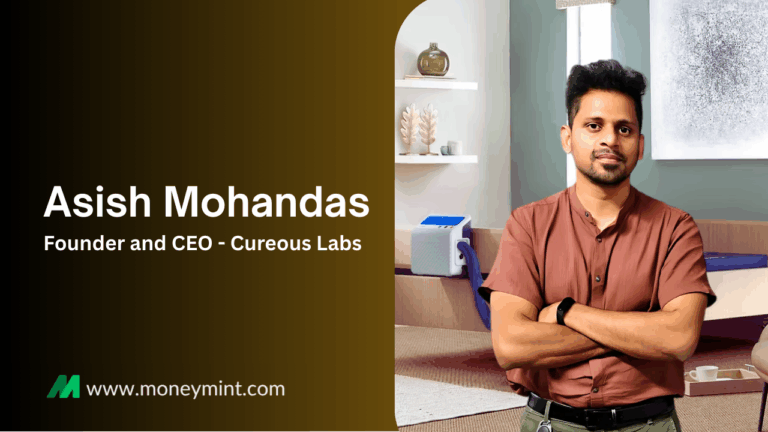Gone are the days when TVs were locked in cupboards in Indian households. Many of you may not know this, but with the introduction of television in India, this was not a rare scenario in families. It needed protection because it was expensive and a luxury at that time. But today, with technological advancement, TV has become affordable and advanced, along with being backed by an operating system.
Among those leading this evolution is Abhijeet Rajpurohit, COO and Co-founder of CloudTV, India’s first certified homegrown Smart TV operating system, who shares his journey of building an OS that is truly made for India.
In an interview with him, Aditya Farrad from Moneymint learned about his journey and insights on CloudTV.

Abhijeet, I’ve read about your inspiring shift from hardware to software. Was it helpful being early in this field?
“Our goal was always to democratize content distribution because that’s what this company was founded on. Before we moved into hardware, we were a streaming company. Then we asked ourselves: How can we make this more streamlined?”
Realizing a huge gap in the Indian market where OTT was only being discussed on mobile and never on TV. Abhijeet believed TV was the final form factor.
There was a lot of fragmentation among OEMs, especially with Android. Did you see this as a market challenge?
“Exactly. So, we asked, why not work with the ecosystem to solve the problem instead of looking at it through a narrow lens? That’s when the OS came into the picture.”
There were Android, Samsung TVs. Was it not difficult to address the market gap with such competition?
“Yes. Competition was there, is there, and will always be there. At the end of the day, competition drives the ecosystem forward. If someone in the ecosystem can not only compete for the same pie but actually grow the pie, it benefits everyone, not just us.”
We’re seeing this level of adoption really in Tier 2 cities and beyond. Is most of the growth in these regions?
Yes, a lot of the momentum is coming from Tier 2 and Tier 3 cities. We’re still at a very early stage. Especially when you look at how many households actually own a smart TV or have consistent access to high-speed internet, but the trajectory is extremely promising. As connectivity improves and affordability increases, these regions are set to drive future growth. We’re just getting started.
Does it take that long for founders to see impact, and is overnight success just a myth?
“I wouldn’t say we’ve arrived yet, because the market is still constantly evolving. OTT itself is an extremely dynamic industry. Digital entertainment hasn’t reached its full potential. I think for the next 20 years, we’ll continue to see significant changes. Television is what it is today because of the value it holds in the living room, but we don’t know what the form factor will be next.
“It could shift to glasses, projectors, or something else entirely. The way media is scaling, and the way AI is coming in to empower more people to create content in diverse ways, will determine what comes next. Our job is to ensure that whatever entertainment looks like today, it’s delivered to the user in the right way. We also must keep our eyes open to what’s coming next, and pivot or modify our product accordingly.”
Many CEOs emphasize that reinvention is essential for success and should happen proactively, not just in crises. Do you have the same opinion?
“Absolutely. There are always interesting ways to see how things will evolve. Since the smart TV industry is new, the company has the privilege of working with seniors—who have both good and bad experiences—and learn from them.”
I’d love to hear how you got started in this unique industry. What’s the origin story?
“Yeah, like I said, when we started, the founder of this company, Jagdish Rajpurohit, had a clear vision – content distribution should be seamless for app developers, creators, and content owners,” said Abhijeet.
- Early OTT in India was limited due to low internet penetration and subscription reluctance, leading to sparse advertising revenues.
- The initial strategy involved developing hardware like Chromecast and Fire Stick, but pivoting became necessary due to competition with global brands.
- The chaotic Indian TV market had many brands offering poorly functioning software, with a preference for open content consumption.
- The focus shifted to providing a seamless OTT experience on TVs, addressing the lack of TV apps from content providers.
- Collaborations with struggling Indian TV brands allowed for improved software and user experience.
- The demand for smart TVs increased significantly by 2020 due to the COVID-19 pandemic, expanding partnerships from 20-30 to over 250 brands.
- Commitment to accessible entertainment through affordable smart TVs with premium functionalities, empowering regional brands and enhancing user experiences.
And when you were manufacturing TVs, were you outsourcing or building them yourself?
“We weren’t doing full-scale manufacturing. We handled certain models and segments, but most of it was imported. But with the Made in India initiative, things changed for good.”

When you were pivoting from hardware to software, to smart OS, what were the challenges you faced?
“For many companies, pivoting means shifting to an entirely different market. We were fortunate to have built our software and content ecosystem while selling hardware. Partnering with other manufacturers felt natural since we didn’t fully control the hardware.”
According to Abhijeet, the challenges in streaming and entertainment remain, but the major part is to tailor it to the tastes and preferences of viewers. Personalization is the key that should be met for each brand as per its needs.
Earlier, you were B2C; now with CloudTV, you’re B2B. How did the transition happen? Was it difficult? Did some see you as a competitor?
“Yes, some people did perceive us as a competitor.”
Do value-conscious consumers define the Indian market? How do you balance that with different expectations?
Not every customer has the same priorities; some value product quality over price, while others seek the best deal regardless of quality. CloudTV operates nationally and regionally, catering to a diverse customer base. Abhijeet notes that pleasing everyone in such a complex market is challenging, which is why they collaborate with many partners rather than focusing on a single product or brand.
When you work with a national brand, do they get a different kind of service or tech compared to a regional brand?
“There is a difference, but we don’t decide that. Some national brands we work with have both premium and budget models with the same panel sizes but different internals. That way they don’t lose customers who don’t want to buy a premium TV but still want a decent secondary one,” added Abhijeet.
How does your tech work? Is it integrated inside the TV, or is there a set-top box?
“It’s built into the TVs. When you make any OS or software, you have to work with specific chipsets. In TVs, we integrate our solution into the chipset and enable support for various panel types and hardware specifications.”
And when you work with over a hundred brands, is the tech the same across them?
“We put in significant effort to make our solution adaptable. Even if the product is similar, it has to be compatible across different brands and specs. We conduct extensive QA and testing with each brand to ensure that the final product is fully certified.”
Can these brands create their own OS to compete in India?
Anyone can make an OS, but scaling across millions of devices is what matters. Creation and distribution are not the same.
Since you’ve experienced both B2C and B2B, what’s the key to learning from both?
“The biggest learning is that B2B stakes are higher. We’re not just B2B but B2B2C. So whatever expectations we had from customers in B2C apply here too.”
How do you see AI impacting your industry?
“AI is exciting. We are already using AI voice assistants for language recognition, and soon, they will be used for content recommendations, reducing the need to search. AI is set to change advertising as well. Instead of irrelevant ads on linear TV, you’ll see personalized ads that you can interact with, making them more engaging and relevant to your interests.”
So, do you see yourselves playing a bigger role in TV advertising, or will that be up to the OEMs?
“We’re already involved. We’re running pilots and figuring out how to build this ecosystem. It’s still new in India. There’s a knowledge gap, and we’re helping educate brands on how their ad spend on connected TVs can deliver better targeting.”
Do you think the whole digital ads ecosystem—a bit like Google Ads with bigger publishers and partners—will shift to TV?
“I think the ecosystem won’t just shift but evolve. There will be a new way to show ads on TV that’s more brand-centric and opens access to smaller players, showing relevant content to the right audience at the right time. That’s the shift we’re working toward.”
What’s the future of CloudTV? Where do you see the company in five or ten years?
“Ten years is a long horizon, but in the next five years, CloudTV will evolve beyond a smart TV OS and become a full-fledged media company. TVs will centralize the living room by incorporating services and removing set-top boxes.”
What challenges and gaps exist for new entrepreneurs today?
“My journey has been a bit different. We didn’t build a product out of just passion. We built it to solve a real market problem. That’s key. Many entrepreneurs get lost in passion and quit when they don’t get results.”
Key Takeaways by Abhijeet Rajpurohit:
- Follow your passion, but prioritize solving a meaningful problem.
- Avoid quitting if outcomes don’t meet expectations.
- Stay focused on the problem you’re addressing.
- Be open to pivoting, but don’t do it just because it’s trending.
- Solve a real problem, and funding will follow.




